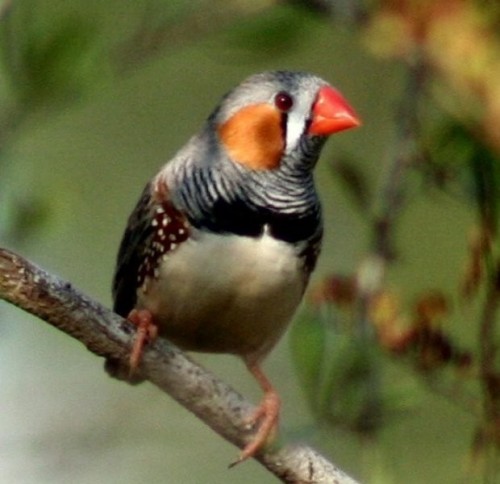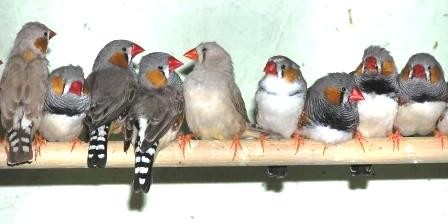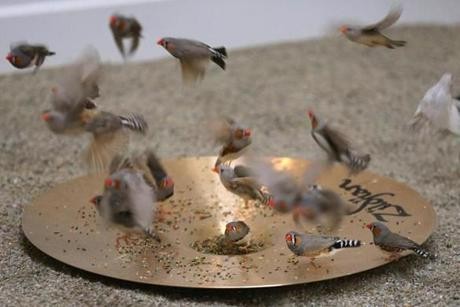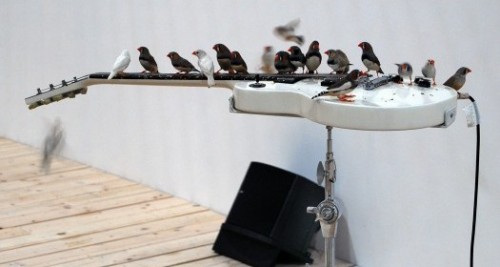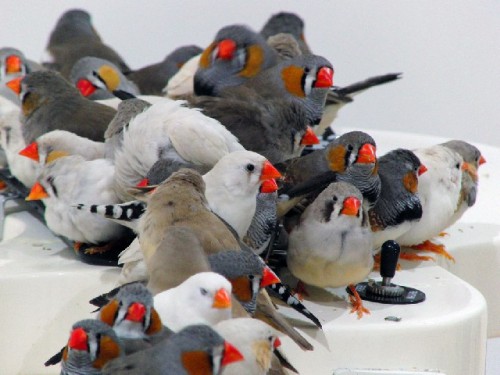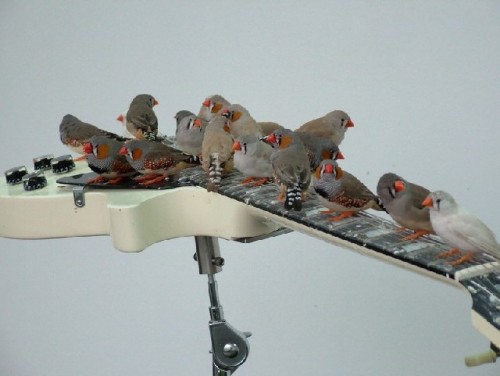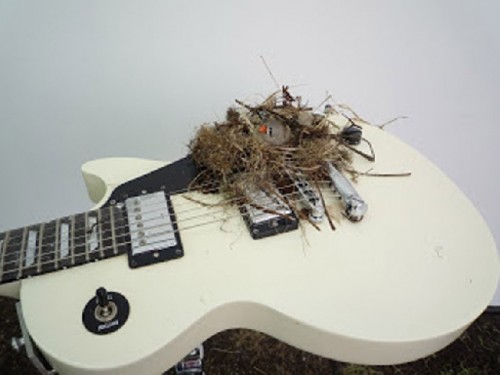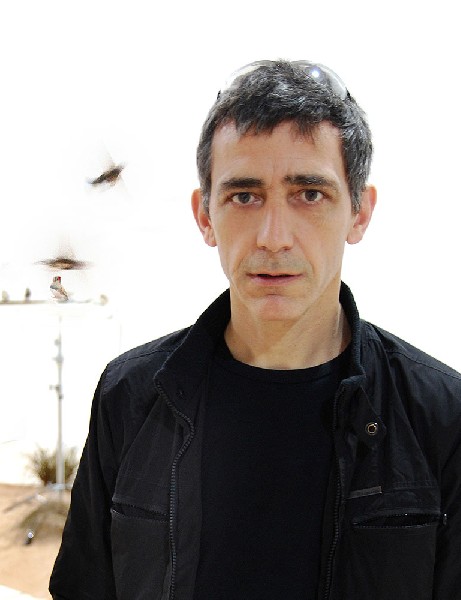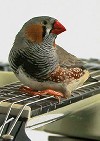FreePort [No. 007]: From Here to Ear
Musical Performance Art By Birds at Peabody Essex Museum
By: Lisa Ann Mello - Feb 18, 2014
The Australian Zebra Finch has a new gig.
They're jammin’ at The Peabody Essex Museum (PEM) in Salem, and they're making beautiful music. In FreePort [No. 007]: From Here to Ear, celebrated French artist Céleste Boursier-Mougenot has revamped PEM's Barton Gallery into a magnificent aviary for an eye and ear-opener in performance art.
As 70 Zebra Finches discover their surroundings and respond to museum goers, they perch on the necks of 14 amplified guitars, revealing the music made in their rhythmic vibrations.
"Boursier-Mougenot invites us into a three-dimensional score where the randomized activities of finches creates a sonic experience that is at turns melodic and ambient," says exhibition curator and PEM's Curator of the Present Tense, Trevor Smith. "This boundary breaking installation embraces the element of surprise, while asking us to consider the way we perceive, create and interact with music."
Only 20 guests at a time, patiently await entry through a chain mail curtain designed to protect the birds, not knowing the surprise on the other side: a most peaceful, intimate space in commune with the birds.
A U-shaped rubber carpet provides a viewing post for the guests to hang with their peeps. Surrounding the walkways, the floor is layered with shallow, sand filled areas with clusters of twigs, the source of the birds’ nests.
The containers formed by upside down symbols, placed in the sand, provide tiny vessels for the birds food and water. And finally, their instruments! Amplified guitars placed on stands perpendicular to the floor provide the perches for the birds.
Thus the birds chirp and flutter from nest to nest, nest to rest, food to drink, and to relax and rest on the guitar strings along the guitar necks. The delicate quivering of their feet, body and wings, make beautiful music amplified for our listening pleasure. This concert could rival any of the greats.
Always moving, the finches work together on their nests. With multiple nests hanging from the ceiling, all the action takes place at nest level about 6 feet high and below. Each nest looks like a bunch of grapes. Each "grape" in the cluster is a hollow, woven globe with a round opening in which the bird can swoop in with its dried twigs.
Graceful like hummingbirds, but slow enough so that you can appreciate their movement in a holding pattern, the birds move quickly in and out of various grapes, building their nests in their upscale avian condo community.
Why the Australian Zebra Finch? According to the artist, he first tried sparrows, but they were too messy and not comfortable enough in the environment. Quite literally, they stunk. Clearly the exhibit wasn’t intended for all the senses.
Enter the Australian Zebra Finch: a most delicate looking, simply beautiful bird with notable markings. The birds are very gregarious, floating around doing their thing. They're so friendly and comfortable that they make the visitor feel at ease.
A note catches your ear, you look up to find its source. Tracing the sound back to an amplifier, along the cord to the guitar, and finally, to its wee musician alight on the guitar strings. Again and again and yet again…it’s fantastic!
At its best, it’s 20th-century experimental music, in which chance plays a major if not specific part. The charming performers of From here to ear captivate viewers with their physical beauty, their extroverted companionship, and their mesmerizing sound.
The birds came to the exhibit from professional breeders, are cleaned and fed twice daily, and are monitored by a veterinary doctor. The birds rest in the hanging nest "condos" and special UV lights gradually come up in the morning and down again in the evening, so the birds maintain a healthy circadian rhythm. All the comforts of home are included for the finches within their exhibit space.
The gallery is set up to keep the audience close, but away from the performers’ daily habits. Sand islands form pathways allowing the birds sanctuary and providing the museum exhibit with a logical way to deal with what birds do naturally after eating. Unlike other exhibitions, the PEM has to follow a health code for this show. A museum interpreter is present to answer any questions as well as ensure the safety and well being of the birds.
I asked my 12 year old son if he thought we were in the birds’ environment. He thought not because we are not in their natural, native element. However, one doesn't get the feeling that they are the visitors in a museum. The people are! We are guests inside the most calm and serene, dare I say, the most fascinating and coolest birdhouse ever. It is an exhibit of art that takes on a life of its own. Because, as artist Boursier-Mougenot believes, "music is waiting to be revealed everywhere."
Credit the artist, for a most unique experience, allowing us to be a part of performance art like no other. Not negatively, it is for the birds, or rather by the birds. And clearly it is for people, too, as this is a concert that one wants never to end.
The Paris-based artist Boursier-Mougenot can apparently find musical potential in just about anything. In the past two decades, his sonic adventures have included getting vacuum cleaners to play harmonicas. Pieces of floating crockery have doubled as percussion instruments. Curbside trees blowing in the wind and even feedback from recording equipment have all been translated into sound art.
He originally trained not as an artist but as a musician at the Conservatory for Music in Nice. His time as composer for the avant-garde Pascal Rambert theatre company for 9 years pushed his work into experimental directions. Starting in the early 1990s, he began to stage sound installations in art galleries. These venues allowed his ideas for compositions to unfold over long stretches of time.
His approach incorporates John Cage's belief that "everything we do is music.". But he does not embrace the chaos of sound that floods daily life on its own terms as Cage did. Instead, he creates highly orchestrated situations where something as random as where a bird chooses to alight or how the wind brushes through a tree's leaves can create new kinds of often hidden music. The charm of this experience is everywhere in this PEM exhibit.
From here to ear, is a great place to hang with the peeps at the PEM through April 13, 2014. Birds of a feather and all that…

